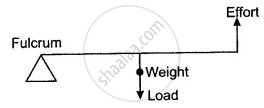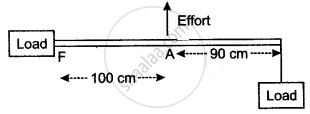Advertisements
Advertisements
प्रश्न
State the principle of a lever?
उत्तर
A lever works on the principle of moments. For an ideal lever, it is assumed that the lever is weightless and frictionless. In the equilibrium position of the lever, by the principle of moments,
Moment of load about the fulcrum = Moment of effort about the fulcrum.
Load × Load arm = Effort × Effort arm
APPEARS IN
संबंधित प्रश्न
A man uses a crowbar of length 1.5 m to raise a load of 75 kgf by putting a sharp edge below the bar at a distance 1 m from his hand.
- Draw a diagram of the arrangement showing the fulcrum (F), load (L) and effort (E) with their directions.
- State the kind of lever.
- Calculate:
- load arm,
- effort arm,
- mechanical advantage and
- the effort needed.
Which type of levers have mechanical advantage always more than 1? Give reasons.
Give three examples for leavers of second order.
The following belong to which class of lever?
Wheelbarrow
When we want to use a machine as a force multiplier, which class of lever should we preferably use? Give a simple diagram of such a lever.

What is a lever?
The diagram shows the use of a lever.

- State the principle of moments as applied to the above lever.
- Which class of lever is this? Give an example of this class of lever.
- If FA = 100 cm, AB = 90 cm, calculate the minimum effort required to lift the load.
State the types (or kinds) of lever, and give two examples of each kind.
A crowbar of length 100 cm is used to lift a load of 5 kgf. It has its fulcrum at a distance of 20 cm from the load. Calculate:
(i) the mechanical advantage of a crowbar and,
(ii) the effort applied at the other end.
A lever is used to multiply the force.
